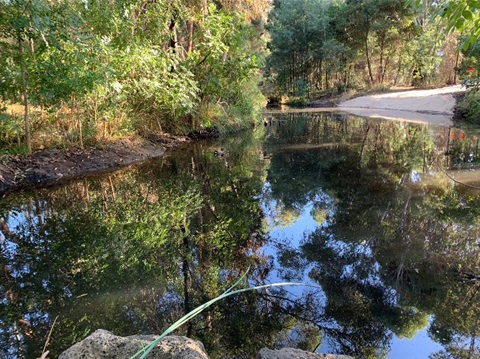Desilting, a good clean-up that improves the health of our wetlands

It’s not often you get the chance to transform what appears to be little more than a dirty puddle or a muddy depression – clogged with thick, not particularly pleasant-smelling mud, overgrown weeds, dead leaves and, in this case, a lonely half-drowned orange traffic cone.
Recently a combined Council effort - involving Sustainable Monash, Engineering, the Bushland and Wetland Team and Capital Works – had the chance to do just that when it carried out works that not only beautified a small green space at a popular reserve in Ashwood but achieved an important environmental outcome along the way.
The Holmesglen Reserve Sediment Pond - situated in Power Avenue, Ashwood - forms a key component in the constructed wetland system in this location. The Holmesglen wetland system naturally filters stormwater from the surrounding residential streets, capturing most of the sediment, litter and debris and improving the quality of stormwater runoff before it washes into Gardiners Creek.
A sediment survey at the site early in 2024 found that the level of sediment accumulation was extremely high (around 80 per cent) and that this asset required sediment removal to reinstate its proper function.
In February and March 2024, Council undertook works to remove the sediment, improving both the visual amenity and environmental health of the pond – a transformation from mud puddle to picture-perfect forest waterhole.
“When you see the before and after photos, it really shows the difference we can make,” Emily Payne, Water Sensitive Urban Design Officer, said.
Initial works at Holmesglen Reserve involved site establishment - including site facilities, sediment controls and temporary fencing - and the installation of an access track between the existing access path and the pond, using crushed rock.
The removal of sediment, litter and debris from the sediment pond required the use of an excavator and the loading of debris onto trucks before its removal to a sediment drying location in a grassed area adjacent to the pond. Sediment was stockpiled for a couple of weeks to dry and, while the sediment was drying, the other plant and equipment were removed from the site. After sufficient drying, equipment was then returned to the site to load the sediment onto trucks for its disposal.
During the sediment removal works, access to the reserve was maintained but a number of carparking spaces were needed for works equipment. Traffic management and an electrical spotter (because of the powerlines in the vicinity of the work site) were also in place.
Fortunately, no trees were removed – only weeds, some grass and a small number of shrubs. Trees around the pond were protected during the works and groundcover will naturally re-grow over time.
The Holmesglen Reserve project had its challenges.
“The biggest problem is the unknowns, the volume and the final weight of sediment after drying,” Emily said. “Last winter we did a sediment estimate with a wetland specialist.”
Sophisticated methods were used to conduct this estimate, including use of a high accuracy global navigation system, a remotely controlled boat with sonar, a drone view of the pond, comparison against the engineering plans and water level assessment.
“But it’s still difficult to be exact (until you remove the sediment from the pond),” Emily said. “(And) you don’t know the degree of contamination. So we test the sediment in situ, in the pond, and then in the stockpile.
“These factors can significantly impact upon the project cost.”
Desilting works, like those conducted at Holmesglen Reserve, are vital for restoring the functioning of our wetlands. Monash has more than 40 wetlands and ponds that Council manages, and this includes undertaking desilting periodically.
Each individual project presents its own unique problems.
“The rate at which sediment and litter comes into the system (varies from site to site),” Emily said. ”You don’t want sediment getting into the wetland, as that will cause problems for its capacity to provide water treatment and it is difficult to remove.
“Construction activity in the catchment can be a big problem, but there are sediment controls that builders can put in place to reduce the amount of sediment mobilised in stormwater runoff.
“And then the other big thing is litter, particularly in the Gardiners Creek catchment.
“There’s the visual amenity (to consider) but it all keeps washing down through the system - Dandenong Creek, Scotchmans Creek, Gardiners Creek – and eventually it reaches Port Phillip Bay.
“And, apart from sediment, there’s a wide range of other pollutants that go along with that.”
Sustainable Monash – Handy links, News and Events
Subscribe for the latest local and global news, updates and events related to sustainability. Receive tips to help you live, work and study more sustainably, and hear from local people in our community who are making changes to care for, and protect, our planet:
Sustainable Monash - News and Events | City of Monash
Sustainability for Schools and Community Groups
As part of our Sustainability Education Program, Council offers a range of FREE education outreach options for schools and community groups in the City of Monash. These include school visits, resources, and workshops. Topics we can cover include waste and recycling; circular economy and waste reduction; biodiversity and nature; and composting.
Learn more about our programs: Sustainability for Schools and Community Groups | City of Monash
There’s plenty going on
Read more about the many community groups making a difference in Monash
We’re helping Mannix College put food waste to good use | City of Monash
Local Sustainability Hero puts the lens on a better world | City of Monash
Monash Seed Library, helping the community’s green thumb | City of Monash
It’s not easy being Green, well Brentwood reckons it is | City of Monash